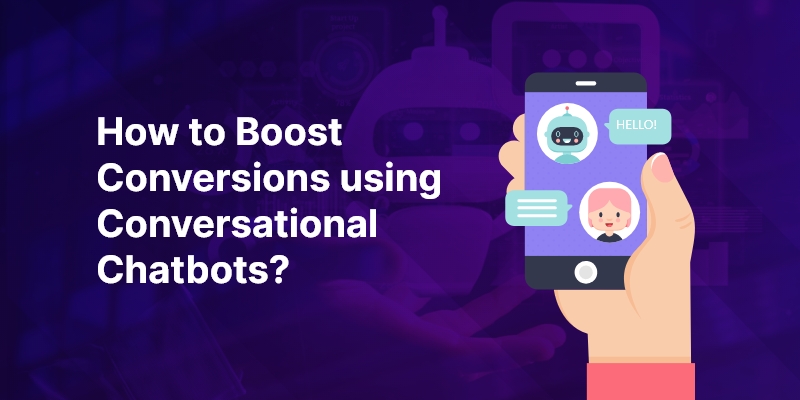How to Boost Conversions using Conversational Chatbots?

Conversation is the beginning of every relationship. Even a stranger can make a big impression on you if he strikes an interesting conversation. Effective conversation has the ability to get your attention, interest, trust, etc. In marketing slang, it can move you through the funnel. Implementing a conversational marketing approach in your website is a great way to get your visitors’ engagement and can make wonders for your business.
What is Conversational Marketing?
Conversational marketing is an entirely dialogue-driven, customer-centric approach that leverages easy-to-use customer-facing solutions like chatbots to drive customer engagement, lead generation, and conversion.
Why Conversational Marketing is Important?
To answer this, we would like to quote a phrase from the book titled ‘Conversational Marketing: How the World’s Fastest Growing Companies Use Chatbots to Generate Leads 24/7/365,’ written by David Cancel.
“Remember: Your company’s brand isn’t its logo or its mascot or its mission statement. Instead, your brand is a reflection of the experiences people have with your company. And every single interaction contributes to how your brand is perceived.”
David Cancel
Author
When to implement conversational marketing?
Chatbots and Conversational Marketing
Chatbots are one of the easiest ways to put conversational marketing into action. Rather than adding a variety of lead capture forms and waiting in the darkness whether visitors will fill in or not, conversational chatbots can instantly strike a conversation with them and convert them using dialogue-driven methods.
Further, with targeted messages, conversational chatbots have the ability to move the prospects down the funnel and enable quick conversion.
“82% of consumers see getting an immediate response as very important when they have a question, something conversational marketing chatbots are very effective at providing.”
Can Rule-based Chatbots Do Conversational Marketing?
Simple answer. No.
Rule-based chatbots (more often the ‘free’ chatbots) work strictly based on logical rules and fixed decision trees that often lead to frustrating user experiences. AI-powered chatbots engage users in a natural conversation. The below table will help you understand further.
| Rule-based Chatbots | Conversational Chatbots |
| Keyword-based | Charged by artificial intelligence |
| Cannot understand typos and grammatical errors | Understands typos and grammatical errors and responds to questions |
| Works based on preset rules | Leverages machine learning capabilities |
| Gets stuck with wrong inputs | Understands the context and delivers relevant answers |
| Scalability issues | Flexible and Scalable |
| Difficult to train and update | Easy to train with historical data |
| Robotic experience | Human-like conversational experience |
Conversational Chatbot – Why it makes better conversion?
We live in a world where the average human attention span is 8 seconds and if you don’t capture their interest within that time, all your marketing efforts can be declared dead. From increasing website page load time to optimizing for better ranking, writing fancy and attractive headline copies, and adding compelling CTAs, we do all the tricks to gain visitors’ interests. Yet, there is always a big gap between the conversion rate we want to achieve and the one we generate.
Conversational chatbot takes a sweet spot like a front desk agent on your website and immediately gets the interest of the visitors who are looking for instant answers.
Striking a conversation is the ideal way to know better about the person you are talking to. And, being able to do it round the clock without human involvement or getting stuck is a big advantage not just for the brands but also for the customers.
“Thinking about the bot as a frontend representative of your product or service can make a lot of sense, and having a delightful bot that provides a useful service can generate strong attachment to your brand.”
Delivering a personalized experience is the new order of the day. Every customer expects some amount of personalization when interacting with a brand as reduces research time, gives the ability to buy things faster, and trust the brand better.
In fact, 90% of leading marketers say personalization significantly contributes to business profitability.
With email lists targeted to groups and websites becoming more generic experience, for marketers, conversational chatbots have huge potential to close the personalization gap as it delivers a 1:1 personalized experience.
But how?
Every customer goes through a journey or buying cycle before they actually convert. Each cycle represents an intent and conversational chatbots can respond to each intent and engage them more to move them to the next phase.
For instance, during the inquiry phase (mostly the passive or inactive phase), all your customer what to do is just check out your offerings. Mostly, they will not be ready for purchase. AI chatbots can still do some amount of personalization here.
During the evaluation phase (mostly the decision phase), your customer will be keen on knowing more about the product. He/she wants to know all its features and benefits, how it worked for others, see the reviews, learns the use cases. The scope of chatbot personalization widens in this phase.
Mostly, the evaluation phase cannot drive immediate conversions. Hence, they need to nurtured further and that is when the conversion happens.
How to get started?
With evolving customer needs and scattered market conditions, hyper-personalization is the most promising way to drive quick conversations. AI-powered conversational chatbots can deliver it with ease. It not only does its job well but also a cheaper, scalable, and easy-to-use solution.
RoundView offers a super-intelligent conversational chatbot solely built to deliver a hyper-personalized experience right from a moment when visitors step into your site and engage them with meaningful conversations to move them down the funnel and boost conversions. Talk to our experts for a demo.
Free Tips on Implementing Conversational Chatbots
Schedule a free call with our chatbot team if you have more questions. We are happy to help.



